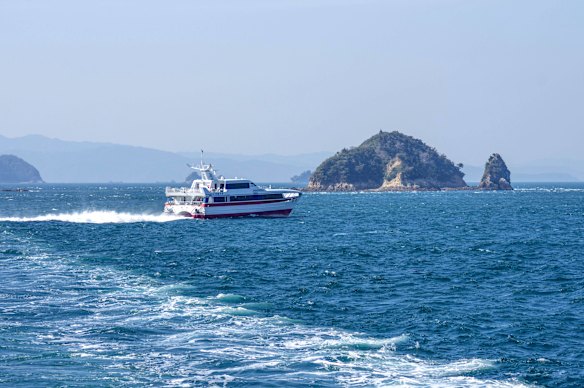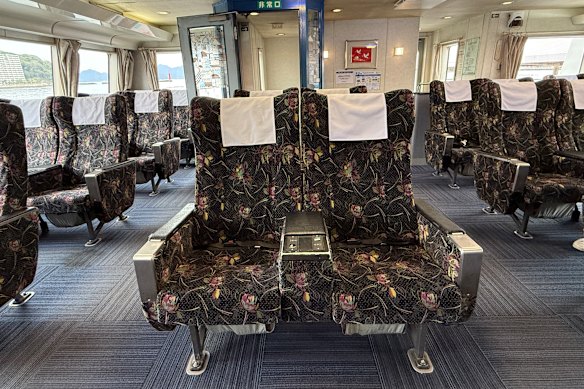
November 11, 2025 — 5:00am
Save
You have reached your maximum number of saved items.
Remove items from your saved list to add more.
Save this article for later
Add articles to your saved list and come back to them anytime.
Got it
For a country comprising 14,125 islands, you may think travelling around by land and sea could be a painstaking, time-consuming task to navigate. Nope, not in Japan.
Besides its extensive train networks and highways, which spread like veins via bridges and tunnels across Japan’s four main islands – Hokkaido, Honshu, Shikoku and Kyushu – travelling by boat proves just as convenient. Japan has a vast network of ferry services, crisscrossing its numerous bays, seas and channels, which make island-hopping an easy, scenic exercise.
 The Super Jet is the fast option for island hopping in Japan.Alamy
The Super Jet is the fast option for island hopping in Japan.Alamy
It’s my third time in Japan, and I’ve yet to experience Japan’s much-lauded (and, depending on the route, sometimes expensive) high-speed train network. Before I do, I’m hopping aboard its other fast ride – high-speed ferries – from Matsuyama, Shikoku’s largest city. It is a 30-minute drive by car from the city centre to reach Matsuyama Kanko Port. From here, I’m headed to Hiroshima on the main island, Honshu.
There are 19 round trips per day between the two ports, crossing the Seto Inland Sea with two sailing options available: the leisurely Sea Paseo via Kure Port, taking two hours and 40 minutes at ¥3500 ($36 based on discount fares for foreigners), or the fast track on the Ishizaki Super Jet direct service, taking one hour and eight minutes for an additional ¥2100 ($22).
As there is little price difference between the two options, I’m taking the Super Jet to Hiroshima, slashing my journey time in half. And for a smoother sail, it’s pocket change to upgrade to the ferry’s “super seating”, akin to business class, at ¥800 ($8). Super seating is located on the second floor behind art deco-inspired doors and can only be accessed by those who upgrade. It is a 2-2-2-2 configuration with large seats and ample leg room.
 It’s pocket change to upgrade to the ferry’s “super seating”, akin to business class, at ¥800 ($8).Julia D’Orazio
It’s pocket change to upgrade to the ferry’s “super seating”, akin to business class, at ¥800 ($8).Julia D’Orazio
While the business class-like upgrade does not extend to services like food and drinks, as in typical Japanese public spaces aesthetics, vending machines are on the below deck (and yes, stocked with beer, too!). Other amenities include a kiosk selling snacks and souvenirs (if you are keen to remember this moment) and free Wi-Fi on board.
My short journey across the Seto Inland Sea is a comfortable ride, and the weather gods are kind with becalmed waters. It’s hardly a bore looking out the window, passing the island archipelago of Japan’s biggest national park, Setonaikai. The park extends across 11 prefectures and includes more than 3000 islands (nearly one-fifth of the country’s islands). I pass a tiny fraction of those islands crowned with forest green with exposed rock at the base.
My ferry ride turns out to be a two-in-one combo with a super quick excursion of Japan’s natural jewel and an inexpensive commute to Hiroshima. Now, to give its fast train services a red-hot go.
The writer was a guest of the Japan National Tourism Organisation.
Sign up for the Traveller newsletter
The latest travel news, tips and inspiration delivered to your inbox. Sign up now.
Save
You have reached your maximum number of saved items.
Remove items from your saved list to add more.
![]() Perth-based writer Julia D’Orazio changed her degree to tourism after her first backpacking trip. She has lived in Estonia, England and France, travelled to more than 70 countries and contributed to international travel books.From our partners
Perth-based writer Julia D’Orazio changed her degree to tourism after her first backpacking trip. She has lived in Estonia, England and France, travelled to more than 70 countries and contributed to international travel books.From our partners


AloJapan.com